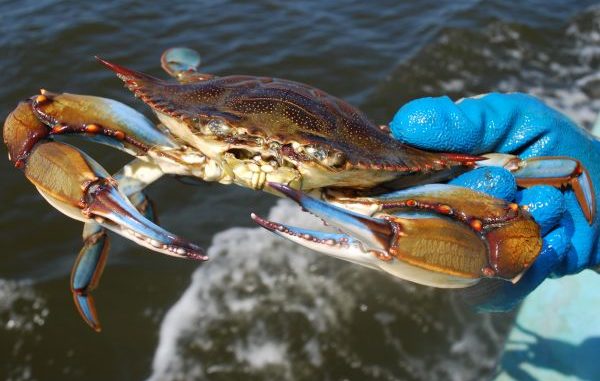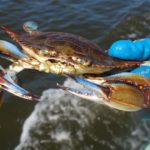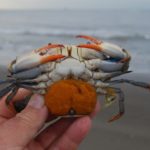
There’s more to this crustacean than meets the eye
The blue crab is one of the most-fascinating creatures in coastal marshes. This is one creature whose scientific name (Callinectes sapidus) completely describes it.
The first half of the name is Greek; “Calli” means “beautiful” and “nectes” means “swimmer.” The second half of the name is Latin, and means “savory — good tasting.”
The blue crab is indeed a swimmer and a member of the swimming crab family Portunidae. Unlike other crabs, which have no paddle-legs and are stuck to mucking around on the bottom, our hero can swim up off the bottom and scull for miles and miles, a feature that is critical in its life cycle.
Blue crabs move a lot — at least for a crab. Adult crabs can be found in pure freshwater, miles up rivers from the Gulf of Mexico and even in landlocked ponds near rivers and bayous. They are also seen miles into the Gulf (where they are a favorite food item for cobia) in full-strength seawater.
But there is a pattern to their appearance. Female crabs bearing large external, sponge-like masses of eggs under their belly aprons tend to be concentrated in the salty waters of lower bays and coastal lakes, and in near-shore Gulf waters.
Spawning is probably done in these high-salinity areas because crab eggs and larvae require at least 20 parts per thousand salinity (full strength seawater is 35 ppt).
Female crabs are very productive. From a single mating made months before, one female can produce eight to 11 broods of eggs. Each brood can have 2 to 6 million eggs.
Spawning occurs at high tide, ensuring that the eggs will be swept into high-salinity areas by a falling tide rather than up into the marsh into areas of low salinity.
The free-floating eggs hatch into larvae called zoea. Strange-looking, they more closely resemble a mosquito from outer space than their crab parents. Over a period of 30 to 50 days, the larval crab molts six or seven more times, each time producing a larger zoeal stage while still helplessly riding the water’s currents.
Finally, the animal molts and reaches the megalops stage, and resembles a very tiny crab with a shrimp-like tail. The megalops stage can be as short as six days or as long as 58 days. It is believed that when they are at this stage they return to estuaries to grow and shed (molt) into a miniature version of adult crabs.
Blue crabs can molt their shells to grow 30 or more times in their lives. Males typically shed more often than females, simply because they live longer.
At 12 to 18 months old, a female will shed her shell for the last time (with rare exceptions) in what is called a “terminal molt.” Before shedding her shell, she will release a pheromone (a hormonal attractant) in her urine that attracts a male. It is while she is in the soft-shell stage following this molt that she mates with a hard-shell male.
The mating takes five to 12 hours, during which time the male cradles the vulnerable female beneath him in what appears to be a chivalric gesture of defense but is probably just intended to keep other males from also mating with her.
Before her terminal molt, the belly flap (called an apron) of a female will be triangular in shape. The apron of a mature female after this molt will be shaped like a dome with a spire, much like the shape of the U.S. capitol building.
After mating, females travel to spawning areas where they all die within a year.
Males, unfair as it may seem, have no terminal molt and can live for at least three to four years, continuing to mate as well as grow and molt. Naturally, this continued molting allows males to grow larger than females.
But we have gotten ahead of ourselves here, as we left off on what happens to small juvenile crabs when they enter estuaries.
Typically, juvenile crabs can be found throughout an estuary, but seem to concentrate their numbers in lower-salinity areas.
Salinities as low as 3 ppt do not inhibit growth, although temperature does. Blue crabs will grow at temperatures of 50 degrees Fahrenheit, although best growth occurs at 59 degrees and above. At water temperatures of 41 degrees, they become dormant and enter a stage of hibernation. High water temperatures — over 86 degrees — also seems to slow growth and molting.
As they grow, however, they begin to segregate by sex. Males tend strongly to move into low-salinity areas, often into completely freshwater areas. Females don’t seem to do well in low salinities, and they congregate in higher-salinity areas.
When a female feels the urge to mate with her terminal molt nearing, she travels into lower-salinity areas to mate with a male rather than vice-versa.
The segregation of males and females into areas of different salinity is never 100 percent. Males are uncommon but not rare in the high-salinity spawning ground frequented by mature females. And some females can be found far up freshwater rivers, much farther upriver than they had to travel to find a mate.
After mating, the female begins the long journey to high-salinity coastal spawning grounds. She doesn’t crawl on the bottom, but rather uses her paddles to swim near the surface, taking advantage of falling tides to advance the journey.
Spawning seems to peak twice a year: late spring/early summer and fall. Some females will do all their spawns before winter sets in. Others seem to spawn in the fall, overwinter and then spawn again in the spring.
At some stage, the females run out of eggs or energy and die. Windrows of their pathetically empty bodies can often be seen on barrier-island beaches in the summer.




